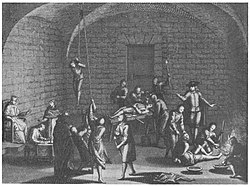Spanish Inquisition
The Spanish Inquisition was a tribunal started in 1478 in Spain. It was started by Ferdinand II of Aragon and Isabella I of Castile, with the assistance of Tomás de Torquemada. During the Spanish Inquisition many people were burnt in front of crowds in the streets. In practice, the Spanish Inquisition served to consolidate power in the monarchy of the newly unified Spanish kingdom, but it achieved that end through infamously brutal methods.
The rulers of Spain asked the Pope to start the Inquisition to catch Jews who pretended to be Christians. In 1492 they commanded all morisco to leave Spain. Many left, but many stayed and said they were Christians. The Inquisition became busy deciding which ones were lying. In 1502 the Muslims were also ordered out. Some parts of Spain actually enforced this order. When Protestants appeared, the Inquisition said they were just pretending to be Christians. Most trials ended with the defendant simply giving up his beliefs and being let go. The Inquisition became less active in later years and was completely abolished in 1834.
Spanish Inquisition Media
Bartolomé Esteban Murillo. The martyrdom of San Pedro de Arbués (1664).
The burning of a 16th-century Dutch Anabaptist, Anneken Hendriks, who was charged with heresy
Auto-da-fé, Plaza Mayor in Lima, Viceroyalty of Peru, 17th century
Diego Mateo López Zapata in his cell before his trial by the Inquisition Court of Cuenca
The Inquisition Tribunal as illustrated by Francisco de Goya
Inquisition torture chamber. Mémoires Historiques (1716)









